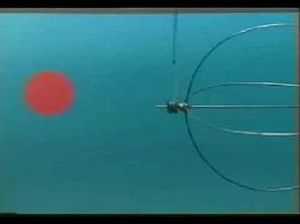Calder's set for Socrate
 | |
| Artist | Alexander Calder |
|---|---|
| Year | 1976 |
| Type | Mobile Set |
| Owner | Joel Thome |
The theatrical set designed by mobile artist Alexander Calder for a touring performance of Erik Satie’s symphonic drama Socrate in 1936, was recreated by the artist in 1976 for a performance in New York. It is a mobile set considered by Virgil Thomson as one of the masterpieces of twentieth-century theatre design. It consisted of three elements a red sun/disc; interlocking steel hoops; and a vertical rectangle, black on one side and white on the other against a blue backdrop.[1]
Background
Although Alexander Calder won international fame for his playful mobiles and giant stabiles, his work for the theatre was virtually unknown, even to close colleagues and admirers. “A sense of drama is evident in much of Calder’s work, and his predilection for strong color, movement and large scale led naturally to the theater,” wrote Jean Lipman in Calder’s universe .[2]
One of Calder’s first work for the stage was the mobile set made in February, 1936 for a production of Erik Satie’s Socrate, sponsored by a group with the amusing name the friends and enemies of modern music. Despite the originality of the piece, it was scrapped after the Colorado Springs performance of Socrate in 1936.
Years Later, when asked about his theatrical productions, Calder singled out Socrate as being particularly meaningful and described it in these terms: «it serves as an indication of a good deal of my subsequent work».[3] It came at a time when he was beginning to move from small, studio sculpture to large outdoor work, and Socrate gave him an opportunity to transpose his moving sculpture to monumental scale. He took the great empty space of the stage and filled it not only with forms but with the movement of those forms through space and time-an exercise more akin to dance than to sculpture. Calder’s contribution to sculpture was to conceive of it as an art of movement. A mobile is a little performance, an abstract dance choreographed by the sculptor.
Recreating the theatrical set
In 1975, Exactly forty years after he had asked Calder to make this socrate set, Virgil Thomson found himself reminiscing about the friends and enemies of modern music with Joel Thome, director of the orchestra our time. Thomson’s vivid description of the 1936 production of Socrate inspired Thome with the idea of re-creating Calder’s lost set. In May, 1975, Thomson wrote to Calder at his home in France, asking his reaction.
Within days the reply came: « It would be fun to revive that bit ». In October, Calder was in New York for his annual visit and exhibition at the Perls galleries. Klaus Pearls arranged a meeting of Calder and Thome and asked Jean Lipman and Richard Marshall, who were preparing for the Whitney museum’s Calder retrospective, to attend. Calder gave Thome his permission for the revival. It was decided that the set would be built in two versions-one the original size and the other roughly one-third smaller-and that work would be done in New York by Walter Hatke, who worked at perls, and who skilled in the restoration of Calder’s sculpture. Calder particularly liked the idea of the smaller set, which could be used in a variety of situations and thus reach a wide audience
The plans were sent to Calder in June, 1976; He signed them and indicated that construction could proceed.[4] The sets were completed during the summer.[5] And in October Calder and Thome met again at perls. They talked about the movement to use a blue backdrop (The only important detail from the 1937 sketch). Calder concluded: « About the rest, you can use your imagination in a theatre». Calder asked Thome to pick him up on November 11th so that they could both go to have their photos taken together with the completed set. As Thome was about to phone to confirm the time, he received word of Calder's sudden death.
Calder’s Tribute
The production of Socrate was postponed for a year and reconceived as a memorial tribute to Alexander Calder. The recreated mobile was as much a part of the production as the music and script. The tribute performances took place at the Beacon Theatre in New York on the 10th and 11 November 1977, both of which were sold out.[6]
References
- ↑ 'Short documentary'
- ↑ John Lipman Calder's Universe page 171
- ↑ Mobiles by Alexander Calder in The Painter’s Object edited by Myfanwy Evans
- ↑ Calder approval
- ↑ Testimonial of Walter Hatke
- ↑ Calders Sets in N.Y "Socrate" The Hour 26 October 1977
| ||||||
Coordinates: 40°46′51″N 73°58′52″W / 40.78083°N 73.98111°W